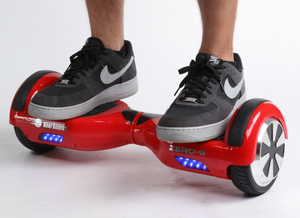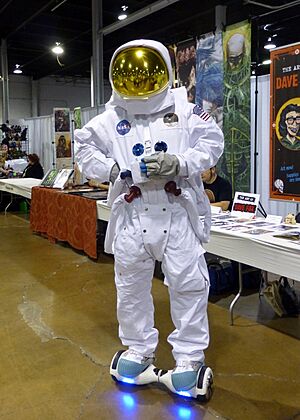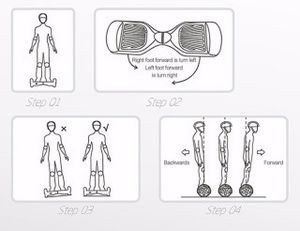Self-balancing scooter facts for kids
A self-balancing scooter is a cool personal ride with two wheels. People often call it a hoverboard, even though it doesn't actually hover! You stand on two pads, and the scooter moves when you lean. Leaning forward or backward makes you go faster or slower. Twisting your feet helps you steer.
These devices became popular around 2014. Early models sometimes had problems with their batteries getting too hot. This led to many of them being recalled (taken back by the companies) to make sure everyone stayed safe.
Contents
How Hoverboards Started
An American businessman named Shane Chen first created a version of this device in early 2013. He even started a Kickstarter campaign to get money to build them.
Hoverboards became super popular in many countries. This was partly because lots of famous people, like Justin Bieber and Kendall Jenner, were seen riding them. Soon, many companies, especially in China, started making these boards.
There were some disagreements about who owned the ideas (patents) for these scooters. But the main goal was to make sure the boards were safe for everyone to use.
Why It's Called a "Hoverboard"
Even though these scooters have wheels and don't float, many people call them "hoverboards." This name comes from science fiction stories and movies.
The word "hoverboard" was first used in a book in 1967. It became really famous from the 1989 movie Back to the Future Part II. In the movie, the character Marty McFly rides a board that actually floats in the air.
Because of this movie, people started using the name "hoverboard" for these wheeled scooters. Even though they don't hover, the name stuck!
How Hoverboards Work
Hoverboards come with different wheel sizes, like 6.5, 8, or 10 inches. They have special sensors and a gyroscope inside. These parts help the board stay balanced.
You control the board by tilting the pads where your feet are. If you lean forward, you go faster. If you lean back, you slow down or go backward. These boards can go from about 6 to 15 miles per hour (10 to 24 km/h). How far you can go depends on the model, the ground, and how much you weigh.
It's always a good idea to wear safety gear, like a helmet and knee pads, when you ride a hoverboard. This helps keep you safe in case you fall.
Newer hoverboards often have a "self-balancing mode." This makes them even easier to ride. The board tries to keep itself level, so it's simpler for you to stay on.
Safety and Issues
In the past, some hoverboards had problems. Their batteries could get too hot, which sometimes caused fires. Because of these safety concerns, many airlines stopped people from bringing hoverboards on planes.
In the United States, a government group called the US Consumer Product Safety Commission (CPSC) looked into these issues. They found that the batteries could overheat and cause fires. So, in 2016, they asked companies to recall (take back) over 500,000 hoverboards. This was to make sure everyone had safe products.
Some health groups also suggested that parents might want to wait until children are over 14 years old before buying them a hoverboard. This was a safety suggestion due to possible injuries.
Today, many hoverboards are made with better safety features. They often have special certifications to show they meet safety standards.
See also
 In Spanish: Tabla de dos ruedas autoequilibrada para niños
In Spanish: Tabla de dos ruedas autoequilibrada para niños
- Caster board
- Electric skateboard
- Onewheel
- Segway
- Skateboard




